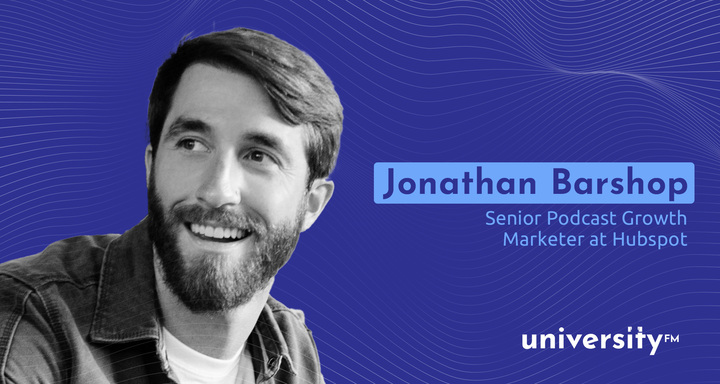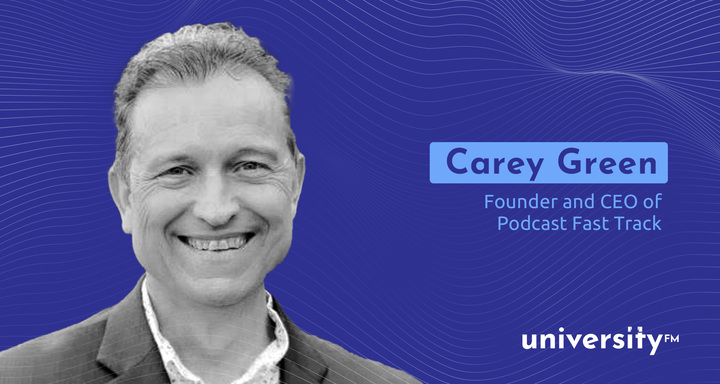
Growing a podcast in higher education spaces takes hard work, networking and consistency. The team behind the This Is Purdue Podcast has implemented these techniques with notable success. During 2021, their overall listener base grew 387% from 2020. The bi-weekly podcast features interviews with Purdue students, faculty, staff and alumni.
To learn more about how This Is Purdue achieved explosive growth, we spoke with Kate Taylor Young, who has hosted the podcast since March 2021.
So how would you describe that growth? Was there any moment where it sort of exploded, or was it more like linear growth?
Yeah, it’s both. There’s a really cool story about when we experienced explosive growth. We did this big feature on Purdue’s All American Marching Band. We were celebrating 100 years with our Big Bass Drum, which is the largest drum in the world. So we love to market that and bring that around every football game. We were playing the Notre Dame football team, and they would not allow the drum in their stadium. So there was the big uproar on social media and how it was going to be the first time since like, the 1970s that the drum wasn’t there. Well, it just so happened that that day the podcast about the drum line and about the big bass drum came out. So we had Sports Illustrated, The Washington Post, local media putting that podcast episode in their articles. And the spike on that day for our podcast impressions was just incredible. So, you know, we had a lot of popularity because the band ran into some bad luck, but in the end, the drum traveled with the band and was on display outside of the stadium for everyone to see!
So tell me a little bit about some of the more strategic elements of your engagement. Do you have a certain posting schedule or a specific engagement schedule where you engage with the audience?
Yeah, absolutely. So our podcast is bi weekly. Every other Thursday, our listeners can expect an episode to drop on all of the major podcast platforms but also on YouTube. We have a YouTube playlist under our official Purdue umbrella. That is for the podcast. We’ll have the main interview go out and then we’ll sprinkle in some additional clips. You know, under-a-minute clips that we also add to social media. We’ll put those on YouTube. Usually we try to have one to two video clips per episode and then we do these really cool quote graphics on Instagram. We’ve seen that having Instagram carousels really help with engagement. So we’ll have a nice photo of the guest and then we’ll have a quote that really stuck out to us from the episode and then a couple more behind the scenes photos so that we’re seeing that engagement boost there with those carousel posts. TikTok is another platform that we’ve seen great growth with, and luckily our amazing social media interns who are students at Purdue help us with it. People are searching TikTok for podcasts. So, we’re gathering these little clips on our phone as we’re shooting the podcast and then they’ll turn them into something for TikTok and repurpose that for YouTube Shorts as well.
Could you share some of your stats?
When we first started, we were getting maybe 500 listens over a month, per episode. So we were seeing 1,000 to 1,500 downloads per month. Now we’re seeing more like 5,000-6,000 downloads per month. From 2020 to 2021, we grew 387%, which is really exciting. That’s combining our YouTube views as well. We do have a bit of a paid strategy for YouTube, so we’re boosting some of the episodes. We found that boosting on social media wasn’t really growing the podcast, but when we’re boosting those YouTube videos, or putting like a trailer clip, almost, to spur people to go to the next full interview, that has been doing really well. So, you know, the past couple of months, we’re seeing like 25,000, 30,000, 40,000 views on YouTube. Which is really exciting.
Do you have any advice for people who are starting a podcast in the higher education space?
Okay, I have a couple here. At the beginning I think it’s really important to have a host that knows your culture, and knows these background stories that make your school what it is, and what makes your school so special. So if they are looking to hire a host, whether it’s a student, a grad student, or an alumni, I think that’s really smart just to have that background info and knowledge. Another thing I’ll say is that podcast stats are so different from what we see with social media channels. With social media it’s like millions of impressions and hundreds or thousands of clicks, right? You’re not going to see that with podcast listens, especially right away. The average number of downloads per episode in the industry right now is 160. So if you’re seeing 160 downloads per episode, over 30 days, you’re already better than half the podcasts out there. Your leadership team or your boss or other people might be like 200 downloads isn’t that many, but think about it—those 160 people just spent 30 or 45 minutes or an hour of their time with your brand, listening to it and soaking that in.
Another thing is building that consistency and letting your listeners know okay, this is going out every Monday or this is going out every other week. That’s really hard, a consistent pattern and show and cadence can be really hard. So just keep going. There’s 2.5 million podcasts out there. Only 380,000 have put out 10 plus episodes and are still active. So people see how hard it is to keep this content machine and this podcast going and they quit after a couple of episodes or a dozen episodes. I think it’s just really important to keep going and not look at how many downloads you’re getting. There’s so many other ways to measure growth, like getting that brand messaging out there even if it’s just to 200 people. And yeah, don’t get frustrated. It’ll come.
Is there anything else that you want to add?
Podcasts are great storytelling vessels for higher ed. You have your newsletters, your blogs, you have of course your social media campaigns or YouTube campaigns, but with a podcast you can have the graphics, the sound bites, and you can put it on to YouTube. You can share it on social media. So it’s a really smart marketing move. We promote the podcast on the radio during Purdue football games and we’ll run different ads while people are in our basketball stadium watching the basketball game. Take the time to work with your campus partners, work with athletics and work with the different schools within your university to cross promote. So just really taking the time to form those connections.




